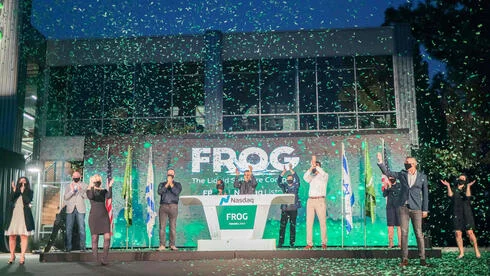From $3.9 billion IPO to $7 billion today: JFrog’s steady climb back to the top

There is no better way to celebrate five years on Nasdaq than the way JFrog did last Friday. The Israeli software company’s stock jumped 27% after publishing financial results that beat expectations and raising its 2025 annual forecast. Following the exceptional surge, JFrog reached a valuation of $7 billion, making it one of the best-performing Israeli tech companies in terms of return since the IPO wave of 2020–2021.
JFrog was one of the hottest IPOs of September 2020. The company went public at a valuation of $3.9 billion, and on its first day of trading the stock surged 62% to $84. Since the beginning of 2025, the stock has doubled in value and is now hovering around $60, though it has yet to surpass its all-time high.
2 View gallery
JFrog executives IPO celebration at NYSE
JFrog employs more than 1,600 people, around 1,000 of whom are based in Israel. Founder and CEO Shlomi Ben Haim, who lives in California, was one of the few CEOs to open his analyst call by referencing the end of the war in Israel, without ignoring the company’s roots.
JFrog has also made a point of acquiring only Israeli startups, with all three of its post-IPO acquisitions coming from the local market.
Why are investors so enthusiastic about JFrog now, and what are the chances this momentum will last? The investment thesis around JFrog centers on its core business: automated software updates without human intervention or version releases, known as DevOps. This field has become one of the strongest in enterprise software in recent years, with surging demand for DevOps professionals who have evolved into a new class within the tech industry.
Unlike many subscription-based software (SaaS) sectors currently shaken by the rise of AI, where large, costly systems risk being replaced by AI-generated code, JFrog’s domain remains more resilient. The company also strengthened its cybersecurity offering with the $300 million acquisition of Israeli startup Vdoo in 2021, which added security layers to its software testing and approval processes, preventing vulnerabilities from entering during development.
At the same time, the rise of Vibe Coding, tools that allow software and apps to be built through verbal and written commands, and the spread of AI agents are opening a new market for JFrog. Code generated by machines could become another major business line.
2 View gallery
JFrog CEO Shlomi Ben Haim
(Photo: JFrog)
In mid-2024, JFrog acquired the Israeli startup Qwak in a cash-and-stock deal to accelerate its entry into the world of AI. The deal brought in about 45 AI-focused employees, a talent pool now considered the most sought-after and expensive in the tech labor market.
For now, AI-related products are not yet contributing meaningful revenue, but JFrog is proving its ability to adapt to the rapid expansion of the cloud sector. Founded in 2008, JFrog is not a “cloud-native” company, yet this is now its fastest-growing business, accounting for nearly half of total revenue.
In the third quarter, which drove the stock’s sharp rise, cloud revenue jumped 50% year-over-year to $64 million, out of total quarterly revenue of $137 million. For comparison, this figure equals JFrog’s entire annual revenue at the time of its IPO five years ago.
The growth in cloud operations also prompted JFrog to raise its full-year forecast, with expected 2025 revenue of $525 million, up 22% from 2024.
Alongside the cloud shift, JFrog is following a broader trend among Israeli software companies, focusing on larger enterprise clients. The number of customers with annual contracts exceeding $1 million rose to 71 at the end of the third quarter, compared to 46 a year earlier.
After Friday’s rally, JFrog is no longer cheap. Its valuation now reflects a multiple of 13 times expected revenue. The company cannot yet be evaluated on an earnings multiple, as it is not GAAP-profitable. Management has prioritized operational efficiency: the gross margin is expected to reach 83% of revenue this year, while operating expenses are projected to drop to 65%, down from 69% in 2024. Still, this is not yet enough to bring JFrog to bottom-line profitability under generally accepted accounting principles.
Excluding non-cash accounting items, mainly from acquisitions and employee stock options, JFrog reported a net profit of $27.5 million in the third quarter. Including those items, it posted a GAAP net loss of $16 million.
As valuation multiples across the U.S. market continue to rise, investors on Wall Street are growing more anxious. The current earnings season has exposed this volatility clearly: strong results often trigger sharp double-digit rallies, while disappointments lead to equally steep declines. The intensity of the reaction is not always proportional to the results themselves, reflecting growing nervousness about a potential AI-driven bubble.
While JFrog still enjoys a largely positive reputation among investors, in today’s environment even a stray remark from a big tech executive can shake an entire sector, or the market as a whole.





